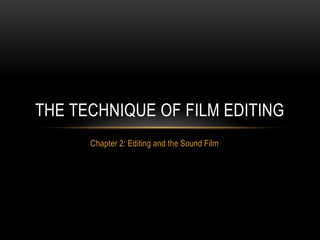
Ch. 2 - Editing and the Sound Film
- 1. Chapter 2: Editing and the Sound Film THE TECHNIQUE OF FILM EDITING
- 2. o “The development of film technique… has been primarily the development of editing.” –Ernest Lindgren o The introduction of sound lead to a regression. All dramatic effects derived from soundtrack. Picture was simply a background. Resulted in a dull and unimaginative presentation. Microphones had to be static on the set. o Despite much resistance, sound in synch with the picture survived by giving the director yet another means to deliver the message. Inessentials can be communicated without wasting shots. Subtle hints in the dialogue or soundtrack. o Two main changes that sound has brought. Greater economy in story-telling. High standard in realistic presentation.
- 3. WHO EDITS A FILM? o The Order of Shots In silent films, Director and Editor worked with much freedom. In sound films, the picture is often locked to the dialogue or sound effects. • Because of this, order of shots must be planned early in production. • In a sense the script controls the order of shots. o Selection of Camera Set-ups: Emphasis Much the same since Griffith first applied it. Outlined in script by Writer. Director has input during production. With a lot of coverage the Editor will assemble how they deem fit. Although planning is the best course of action.
- 4. o Timing In silent films, controlled by the rate of cutting; timing determined by their visual content. In sound films, the Editor can achieve effects not inherent in the picture or soundtrack individually. • Use L-cuts to carry sound from one shot to another; i.e. reaction shots in a dialogue scene. • Play sound and picture in parallel or in counterpoint. • Often minute adjustments that are tough to pre-plan before the material is shot. o Presentation: Smoothness There is an inherent abruptness in cutting between shots. German-filmmakers the first to attempt cutting on movement in a shot. Constructing a smoothly flowing continuity is the main preoccupation of the modern Editor. Most duties are now shared between Writer, Director, and Editor.
- 5. THE CONTRIBUTION OF EDITING o Ultimately, who contributes to the edit will vary from production-to-production. British productions, the Director is the key figure. • Collaborates on shooting script. • Supervises editing. • Final continuity rests with Director and Editor. Hollywood productions, Director follows the writer’s directions in the script. • The Producer is more concerned with the creative process. • Producer supervises editing process. Not always the case, there are exceptions. • Preston Sturges, John Huston; writes and directs. • Charlie Chaplin; writes, produces, and directs. • John Ford; produces. • Orson Welles; solely responsible for Citizen Kane.
- 6. o Who should ideally be responsible for writing? Thorold Dickinson presents a strong case that the Director should control the script. Others propose a Director/Writer/Editor partnership. The Director should normally be in charge. • Responsible for planning the visual continuity during shooting. • Implies control over the edit so it matches the vision on the floor. Most Directors want control but do not insist on writing. • Writing dialogue takes a special skillset. • Writer must have a talent for imaginative visual treatment. When a Director is made to shoot a tight script, film can be static and wordy. In Hollywood, script is written for the star; not necessarily for the story. • Exploit the star’s drawing power at the box office. • Sometimes good films emerge, but not often the case. • Too many creative concessions have to be made in the name of screen time.
- 7. Some films do not owe primary appeal to the Director. • Preston Sturges films; work of a brilliant dialogue writer. Sullivan’s Travels (1941) The Lady Eve (1941) • Good musicals often recognize the Dance Director. • Cecil B. deMille epics; Set Designer is a key figure. The Ten Commandments (1956) Cleopatra (1934) • These films tend to indulge in their own stylistic distortion and do not focus on reality. • When authenticity and realism is the goal the Director must be mainly in charge.
- 8. SPECIAL STYLES OF EDITING o Actual sound created an issue in editing. Action sequences are problematic. Visuals are not connected physically, the actual sound of each shot can become a meaningless jumble of sounds when cut in rapid succession. Must have a unifying soundtrack; music or sound effects. o Early filmmakers in the sound period used symbolism for effect. Alfred Hitchcock, Blackmail (1929) • Uses a painting of a laughing clown. Rouben Mamoulian, City Streets (1931) • Ornamental cats as a sign of jealousy. • Shot of birds in flight outside a prison to symbolize freedom beyond the bars. • Snuffing a match to allude to a murder.
- 9. o Introduction of sound caused filmmakers to focus on realistic narrative and resulted in a discarding of silent film techniques of indirect visual allusion by choice not by limitations of technology. Ernest Lindgren argues that there was no need to abandon these techniques. • Subjective commentary should always be a natural part of the story’s setting. The Russians broke this convention in some of their best works. In October, Eisenstein satires religious ceremonies by using images from religious locations from around the world, completely ignoring the story’s natural locale. o British documentaries of the 1930’s further developed Eisenstein’s theory. Relational Editing, editing to an idea o With Relational Editing and Compilations, the Editor assumes an important role; similar to the silent era. o “At present, one can only hopefully anticipate the films of some future Director, working in the sound medium, but with the freedom of a Griffith, an Eisenstein, or a Dovzhenko.”
